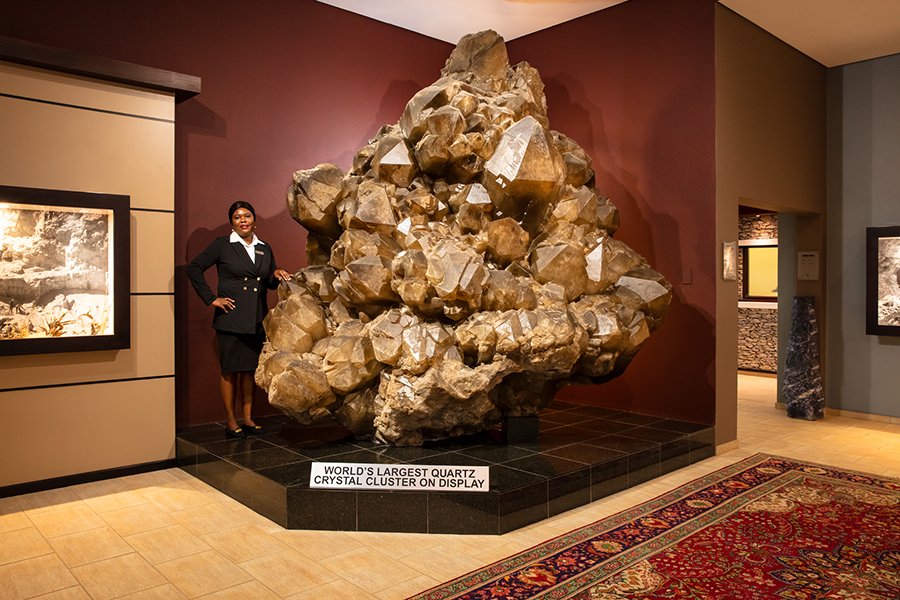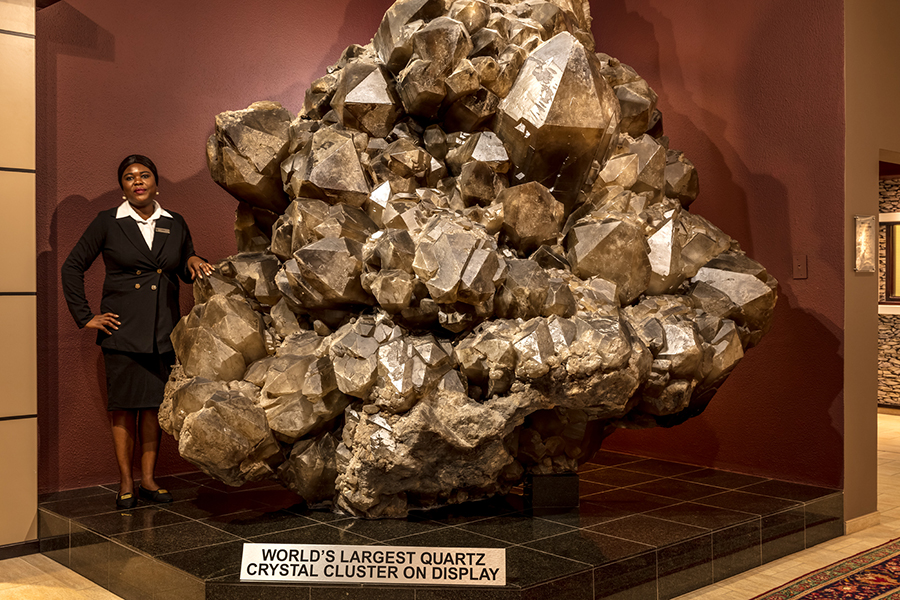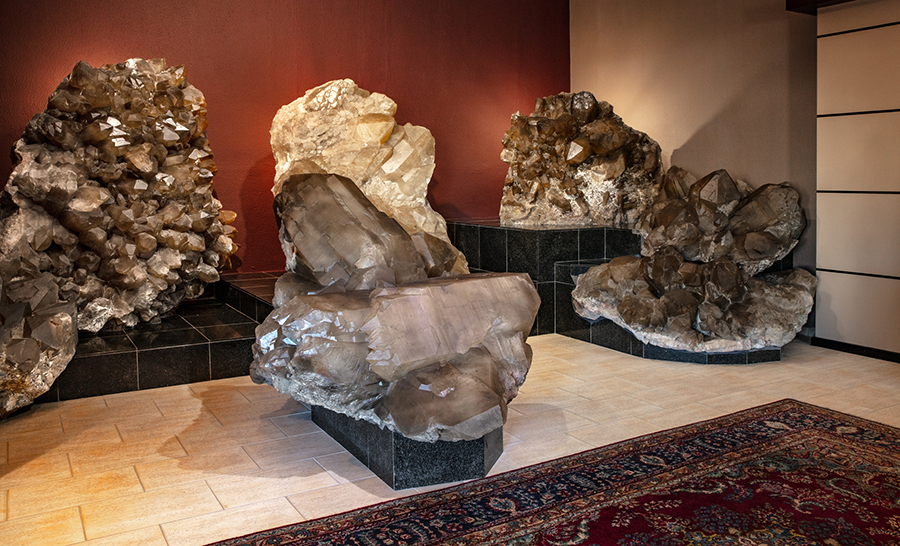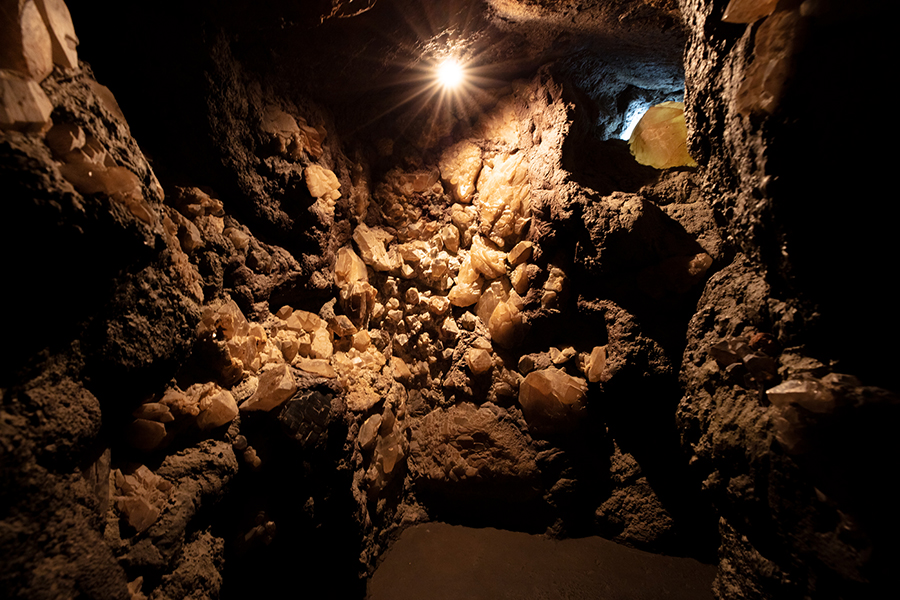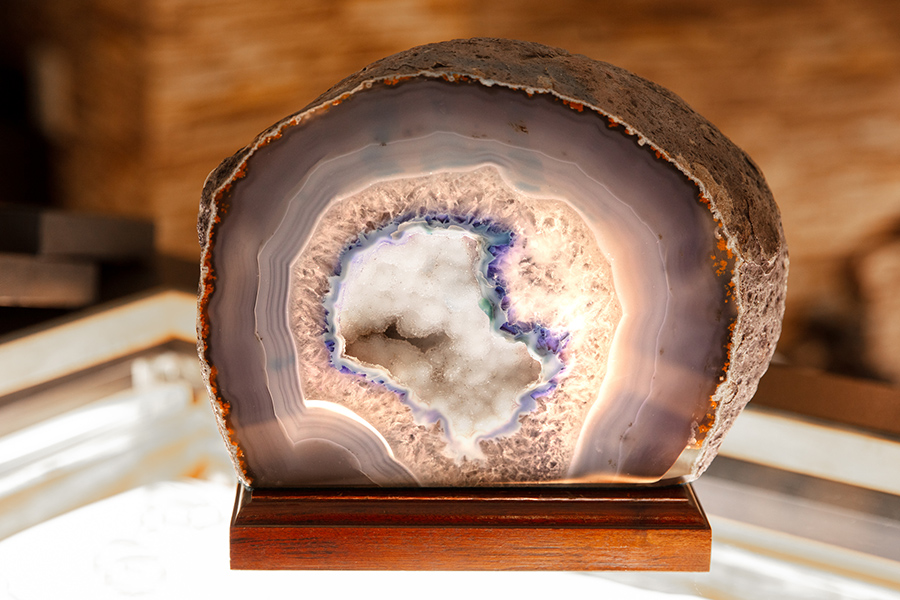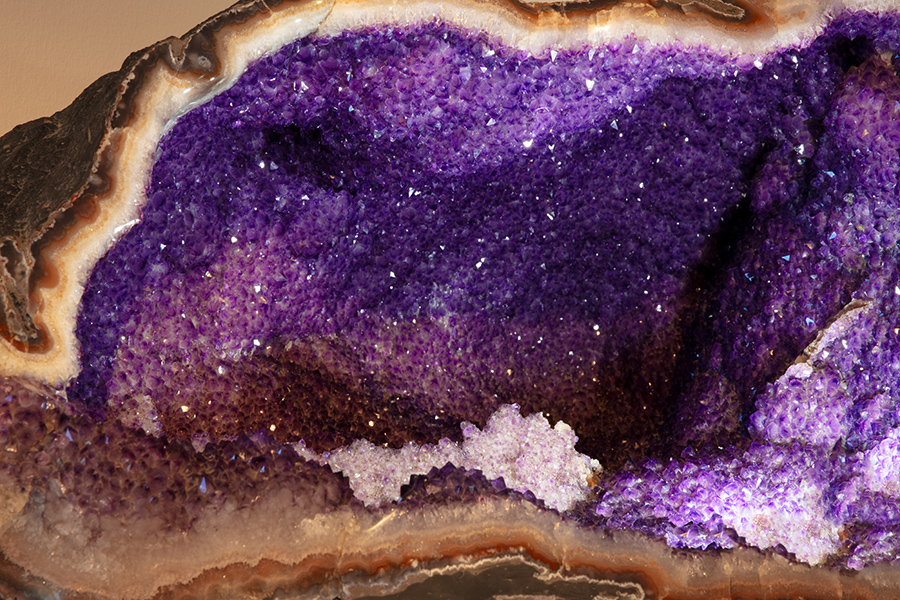Giant Quartz Crystals
Giant Quartz Crystals from the Farm Otjua 37, Karibib District, Namibia and other giant mineral specimen
Giant Quartz Crystals from the Farm Otjua 37, Karibib District, Namibia and other giant mineral specimen
A zoned rare metal pegmatite is mined for its tourmaline content in the northern part of the farm Otjua 37, some 34 km east-south-east of Karibib in the Erongo Region. The pegmatite has a striking length of approximately 2.3 km, it dips almost vertically and its width ranges between 250 and 340 m (Roering, 1963).
The zoning is well developed and consists of the following distinct units from the margin inwards; a perthite-albite-quartz-schorlite border zone, a graphic granite zone, a cleavelandite-quartz-muscovite-schorlite-beryl zone, an albite-quartz-muscovite-perthite-tourmaline zone, a blocky perhite-albite-quartz-muscovite-tourmaline zone, a lepidolite-bearing zone, a core margin zone and a quartz core. The post-tectonic pegmatite has intruded Damaran marbles of the Karibib Formation some 500 million years ago (Roering, 1963).
Milky and smokey quartz form the bulk of the quartz core. In 1987, clusters of huge quartz crystals have been discovered in cavities of this quartz core. Individual quartz crystals measure up to 2m in length and 2m in circumference, while the largest crystal cluster has a size of 44x24x12 meters. Prism and pyramid face are well developed on the crystals and many of them were originally goethite stained and had a coating of calcite. The majority of the crystals have been recorded and they are now displayed at the Kristall Galerie in Swakopmund, with one specimen being on displayed at the Museum of the Geological Survey of Namibia in Windhoek.
As already indicated by the milky appearance of the crystals, most of them contain abundant fluid inclusions. Average homogenisation temperatures as low as 200 C suggest that the quartzes crystallized from very late stage pegmatite fluids. Several of the crystals show selected growth on the pyramid faces, indicating either a rapid depletion of the SiO content of the fluids towards the end of the crystallization process, or secondary dissolution as a consequence of equilibration between solid crystals and mineralizing fluids. The latter would point to a multi-phase emplacement model for the Otjua pegmatite, a phenomenon quite common in Damaran pegmatite's.
Tourmaline occurs together with the large quartz crystals. It is mainly green in color or of the chlorite variety (black) however, a few are so-called "water melon" tourmalines, a variety having a pink core and a green rim. The tourmalines are partly or totally enclosed by the quartz crystals. They are randomly orientated within the host quartz, but it can be observed that none of them occurs parallel to the c-axis of the quartz.
Sizeable crystals have always been a focus of attraction and fascination. As early as 1932, a paper giving the dimensions of a number of known giant crystals of various minerals has been published by C. Palache. Theoretically, it would appear that a growing crystal could increase in size indefinitely if a continuous supply of mineral is available at its surface. Experiments, however, have shown, that the growth ceases with the attainment of a critical size regardless of the amount of material still available. This is very similar to the capability of fluids to form drops, but only drops of a certain limit of size for each kind of liquid. Likewise, the size of crystals is linked to their mineralogical composition (Frondel, 1935).
The largest crystal ever to be described is a beryl from Malakialina in the Malagasy Republic. It occurs in a pegmatite, is 18m long, 3.5m in diameter, has an estimated volume of 143m and a mass of some 380t. Among the many tales handed down from geologist to geologist is the story of a mysterious locality in he Ural mountains, where a quarry is said to have been opened up within a single feldspar crystal. There might even be some truth in it, since Kastor (1968) claims that there are known orthoclase crystals of 10 by 10m dimension and weighing up to 100 t. Regrettably, like many other great crystals, this one was never accurately measured, and so its true discussions remain unknown. Likewise, a microcline reported from the Devils Hole Mine in Colorado, USA, is said to have had dimensions of 49x36x14m and an estimated weight of 16 000 tons, before it was mined. This may have been the largest crystal ever discovered but it cannot be regarded as fully authenticated, particularly in respect to the microcline having been one single crystal throughout.
For a long time the world's largest quartz crystal which has been substantiated was a crystal from Mancho Felipe, Izapore Goiaz in Brazil. This crystal is reported to be 6.1m long, measures 1.5 m across a prism face and has a calculated weight of some 100 tons (Campbell, 1946; Richwood, 1981). I 959, however, the journal "Der Aeschylus" reported the find of a quartz crystal of the size of a two-story-house with an estimated weight of 70 tons from Kasachstan.
Other interesting finds of large quarts crystals have been reported from the Swiss and the Austrian Alps of Europe, many of which associated with tales of mystery and fortune, as well as misfortune. In 1719, four brothers from Meiringen made the largest crystal discovery ever in the Swiss Alps at Zinggenstock. The whole story of this discovery is full of drama and mystery and overshadowed by strange events which have never been investigated or solved. After the discovery in the autumn of 1719, winter settled , and the snow allowed the brothers only to return the following spring. Upon their return, however, they had to realize that 1 000 kg of crystals of the best quality had been stolen. Who were the thieves? How did they get there during the winter time? And where did the crystals go? The riddle was never solved. Despite this unfortunate start, the four brothers worked their little "mine" successfully for four years, during which time they developed a 30 m long admit, which led into a "crystal cavern". But then, in 1723, somebody set fire to the admit, and the mine was almost totally destroyed. Again, officials investigated with no success, and no suspect could be traced. In 1924 the government in Ber prohibited any further mining and the deposit became operational again only from 1731 to 1737. In total, some 50 t of high quality and large quartz crystals are said to have been recovered from Zinggenstock, most of which have been cut and polished in Italy. Only three large crystals remain today in Bern and bear witness to this enormous discovery (Stalder & Jacob, 1966).
Also in Switzerland, in 1867, two men from Guttannen, Bern, discovered the largest cavity containing smokey quartz ever found at Tiefengletscher in the district of Uri. They got so side-tracked with their discovery, that they did not notice the dark clouds gathering over their heads. When they realized the imminent blizzard it was too late for them to return home and they had to fight for their lives during a night of storm and icy snow. However, the next day brought better weather, and eventually the entire community of Guttannen appeared to assist in the recovery of the crystals, since Guttannen belongs to the district of Bern, while the discovery was made in the district of Uri, and the crystals therefore had to be smuggled home! The largest and various museums in Europe. The biggest is called "Grandfather" and has a length of 63 cm, a circumference of 122 cm and weights 133 kg. Grandfather is on display in the Museum for Natural History in Budapest, Hungary (Stadler & Jacob, 1966 ).
More recently in 1965, two mountaineers discovered giant quartz crystals in the area of the Grossglockner in the Austrian Alps at an altitude of some 3 000 m NW. In total, seven crystals were recovered, the largest of which has a length of 116 cm, a circumference of 220 cm and weights 618 kg. It is therefore approximately five times the size of "Grandfather" (Von Deschwanden, 1967)
The quartz crystals from Otjua compare very favorable in size to those described from the Alps, i.e. they are much larger. They are perfect and beautiful crystals, which distinguishes them from their giant relatives described from Brazil and Kasachstan. They are furthermore unique, since many of them are doubly terminated, thus identifying them as "floaters", i.e. they grew while floating in the mineralizing fluid, rather that growing onto the surface. There is no record in the literature for the largest quartz "floater" ever found, and it might well be that Otjua is a floater with a length of 2.2 m and a circumference of 1,8 m. It has an estimated weight of 1 ton and is part of a cluster displayed in the foyer of Kristall Gallerie in Swakopmund.

